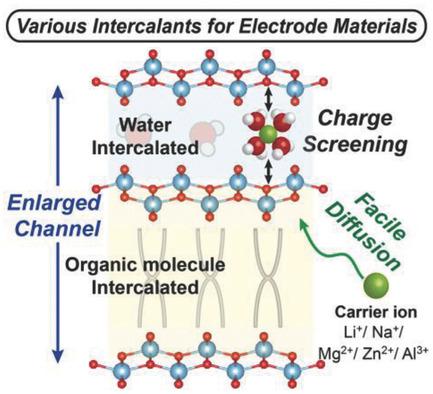当前位置:
X-MOL 学术
›
Adv. Mater.
›
论文详情
Our official English website, www.x-mol.net, welcomes your
feedback! (Note: you will need to create a separate account there.)
Intercalated Water and Organic Molecules for Electrode Materials of Rechargeable Batteries
Advanced Materials ( IF 27.4 ) Pub Date : 2018-03-24 , DOI: 10.1002/adma.201705851 Hyeon Jeong Lee 1 , Jaeho Shin 2 , Jang Wook Choi 2
Advanced Materials ( IF 27.4 ) Pub Date : 2018-03-24 , DOI: 10.1002/adma.201705851 Hyeon Jeong Lee 1 , Jaeho Shin 2 , Jang Wook Choi 2
Affiliation

|
The intrinsic limitations of lithium‐ion batteries (LIBs) with regard to safety, cost, and the availability of raw materials have promoted research on so‐called “post‐LIBs”. The recent intense research of post‐LIBs provides an invaluable lesson that existing electrode materials used in LIBs may not perform as well in post‐LIBs, calling for new material designs compliant with emerging batteries based on new chemistries. One promising approach in this direction is the development of materials with intercalated water or organic molecules, as these materials demonstrate superior electrochemical performance in emerging battery systems. The enlarged ionic channel dimensions and effective shielding of the electrostatic interaction between carrier ions and the lattice host are the origins of the observed electrochemical performance. Moreover, these intercalants serve as interlayer pillars to sustain the framework for prolonged cycles. Representative examples of such intercalated materials applied to batteries based on Li+, Na+, Mg2+, and Zn2+ ions and supercapacitors are considered, along with their impact in materials research.
中文翻译:

可插式电池电极材料的插层水和有机分子
锂离子电池(LIB)在安全性,成本和原材料可用性方面的固有局限性推动了对所谓的“后LIB”的研究。最近对后LiB进行的大量研究提供了宝贵的经验教训,即后LiB中使用的现有电极材料在后LiB中的性能可能不尽人意,因此要求采用与基于新化学方法的新兴电池兼容的新材料设计。朝这个方向发展的一种有前途的方法是开发具有插层水或有机分子的材料,因为这些材料在新兴的电池系统中表现出优异的电化学性能。扩大的离子通道尺寸和有效屏蔽载体离子与晶格主体之间的静电相互作用是观察到的电化学性能的起源。而且,这些嵌入剂充当中间层支柱,以维持框架的延长周期。应用于锂基电池的此类插层材料的代表性示例考虑了+,Na +,Mg 2+和Zn 2+离子以及超级电容器,以及它们在材料研究中的影响。
更新日期:2018-03-24
中文翻译:

可插式电池电极材料的插层水和有机分子
锂离子电池(LIB)在安全性,成本和原材料可用性方面的固有局限性推动了对所谓的“后LIB”的研究。最近对后LiB进行的大量研究提供了宝贵的经验教训,即后LiB中使用的现有电极材料在后LiB中的性能可能不尽人意,因此要求采用与基于新化学方法的新兴电池兼容的新材料设计。朝这个方向发展的一种有前途的方法是开发具有插层水或有机分子的材料,因为这些材料在新兴的电池系统中表现出优异的电化学性能。扩大的离子通道尺寸和有效屏蔽载体离子与晶格主体之间的静电相互作用是观察到的电化学性能的起源。而且,这些嵌入剂充当中间层支柱,以维持框架的延长周期。应用于锂基电池的此类插层材料的代表性示例考虑了+,Na +,Mg 2+和Zn 2+离子以及超级电容器,以及它们在材料研究中的影响。











































 京公网安备 11010802027423号
京公网安备 11010802027423号